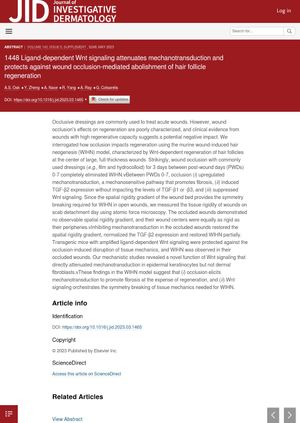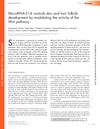Ligand-Dependent Wnt Signaling Attenuates Mechanotransduction and Protects Against Wound Occlusion-Mediated Abolishment of Hair Follicle Regeneration
April 2023
in “
Journal of Investigative Dermatology
”

TLDR Covering a wound can stop hair growth by promoting scarring, but boosting a process called Wnt signaling can help hair grow back even when the wound is covered.
The study investigates the impact of wound occlusion on hair follicle regeneration using a murine wound-induced hair neogenesis (WIHN) model. The findings reveal that wound occlusion with commonly used dressings for 3 days completely eliminated WIHN by upregulating mechanotransduction, a pathway that promotes fibrosis, inducing TGF-β2 expression, and suppressing Wnt signaling. The occluded wounds showed no spatial rigidity gradient, a factor necessary for WIHN in open wounds. However, inhibiting mechanotransduction in the occluded wounds partially restored WIHN by restoring the spatial rigidity gradient and normalizing TGF-β2 expression. Transgenic mice with amplified ligand-dependent Wnt signaling were protected against the occlusion-induced disruption of tissue mechanics, and WIHN was observed in their occluded wounds. The study concludes that occlusion promotes fibrosis at the expense of regeneration and that Wnt signaling is crucial for the symmetry breaking of tissue mechanics needed for WIHN.

